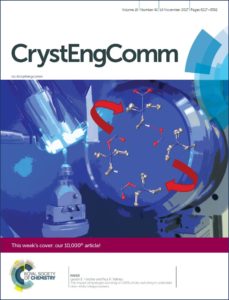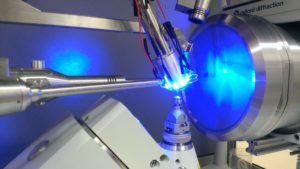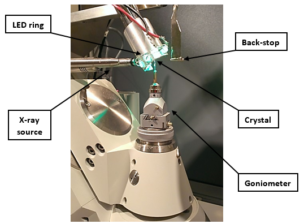When CrystEngComm was established in 1999 as one of the first online-only chemistry journals it published 9 articles in its first twelve months, releasing them online as soon as they were accepted. Since then it has grown to publish more than 1000 articles each year, going from a monthly journal (introduced in 2006) to twice a month (2011) to weekly (2015). Next year we celebrate our 20th issue, but ahead of that we’ve reached another milestone – this week sees the publication of our 10,000th article!
The article, published in Volume 19, Issue 42, entitled “The impact of hydrogen bonding on 100% photo-switching in solid-state nitro-nitrito linkage isomers” is online now and free to access. We spoke to the authors Dr Lauren E. Hatcher and Professor Paul Raithby from the University of Bath about the work behind the article:
| “This paper describing the structural dynamics of light-activated, switchable nitro-nitrito linkage isomers forms part of a programme to develop new materials that will act as molecular switches when exposed to specific wavelengths of visible light. The overall aim of the programme is to develop new materials that respond rapidly and reliably to changes in the local environment and to send out signals to let us know what is happening. Our transition-metal nitro complexes, which can be reversibly switched to metastable nitrito isomers, are our benchmark materials in the development of new molecular switches. This is because they are ideal for crystallographic and spectroscopic studies, which provide the exquisite detail that is needed to design more efficient materials using crystal engineering methodologies.” | 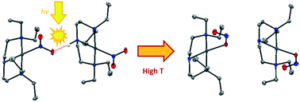
The Graphical Abstract of the article shows the hydrogen bonding present in the ground state structure of [Pd(Et4dien(NO2)]OTf (left) and the metastable endo-ONO state formed by irradiation at 150K (right). |
The work has been highlighted on the front cover of the issue. The cover art shows a stylised view of the experimental set-up. Dr Hatcher shed some light on the experimental procedure:
When asked why they chose to publish with CrystEngComm, the authors had this to say:
| “We regularly publish our work on structural dynamics and metastable materials in CrystEngComm as it is a high impact journal with a broad readership interested in the relationship between structure and material properties and function.” |
Congratulations and a huge thanks to Dr Hatcher and Professor Raithby, and all our authors, for helping us reach this milestone!
| Author Profiles: | |||
| Lauren Hatcher completed her PhD in Chemistry at the University of Bath in 2014, on the topic of Molecular Photocrystallography. She has since continued her interest in switchable molecular crystals as a postdoctoral researcher at Bath, studying crystalline switches that respond to different external stimuli including light, temperature, pressure and gas absorption. She received the Leadership Forum Award for Best Chemistry Student at the European SET Awards (2010), and was recently awarded the 2017 CCDC Chemical Crystallography Prize for Younger Scientists by the British Crystallographic Association. Lauren has a growing publication record, which includes an invited contribution to the 2016 CrystEngComm “New Talent” issue (CrystEngComm, 2016, 18(22), 4180-4187). | 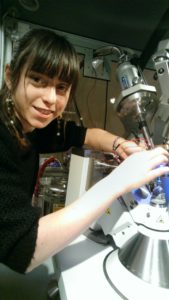 |
||
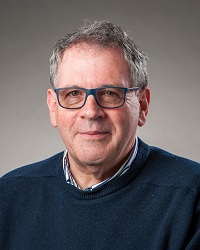 |
Paul Raithby is Professor of Inorganic Chemistry at the University of Bath, prior to which he was a faculty member of the Department of Chemistry at the University of Cambridge for 25 years. He has been awarded the RSC Corday Morgan Medal and Prize (1988) and the RSC Prize for Structural Chemistry (2008). He has over 800 publications and is among the 30 most cited British physical scientists. His research interests span aspects of chemical crystallography, dynamic structural science and co-ordination chemistry. Since 2012 he has led an EPSRC sponsored programme, at Bath, to develop new metastable materials with switchable functionality. |


